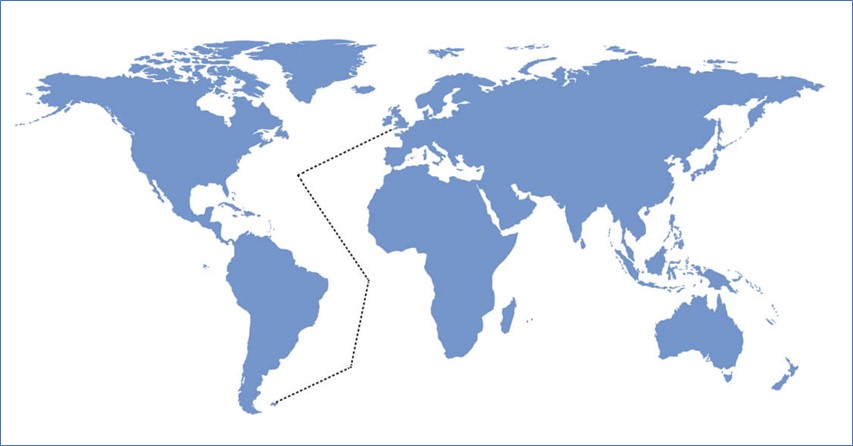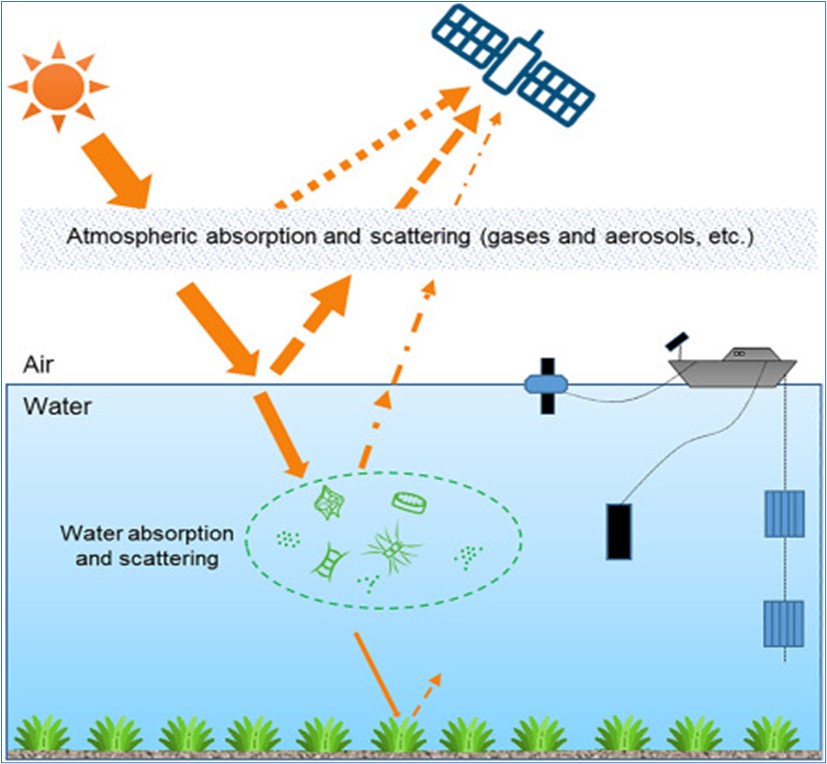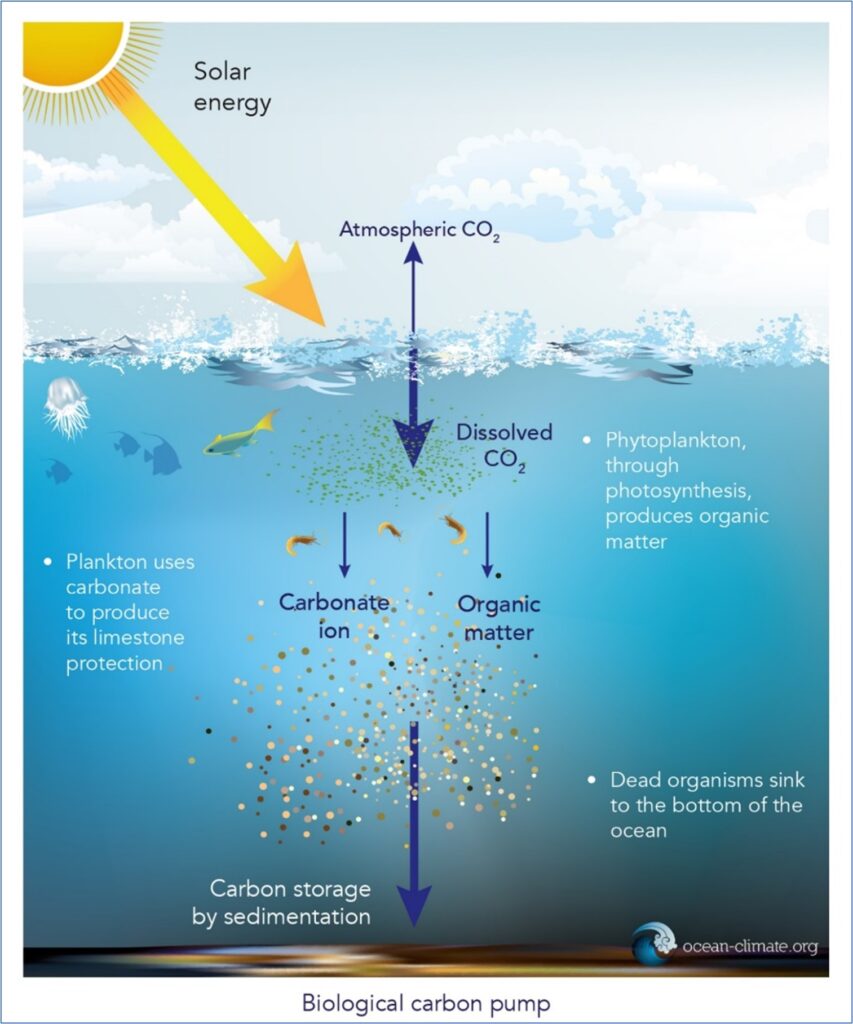By Dawn Ashby, Jennifer Lockett, and Angelina Smilenova | June 27, 2024
Established in 1995, the Atlantic Meridional Transect (AMT) programme is one of the longest running Atlantic Ocean colour monitoring field campaigns. Through its long-term, multidisciplinary approach to oceanographic research, the AMT programme has made significant contributions to the fields of Earth Observation, climate change research, and environmental policy.
The AMT field programme is a true aspiration to the EuroGO-SHIP research infrastructure (RI) concept initiative. EuroGO-SHIP aims to bring together the infrastructure needed for the systematic observing of European marine waters and seas. The provision of new and continuous high-quality hydrographic data will help scientists in their predictions of dynamic ocean changes and assessments of weather patterns changes, the climate status, and the vitality of European marine ecosystems. The data are essential for safeguarding the health of the ocean and the marine life within, as well as living conditions on land.
Starting from the UK, and finishing in Chile, or the Falklands Islands, or South Africa on occasions, AMT transects cover up to 13 500 km, collecting biological, chemical, and physical oceanographic in-situ data.

One of the most remarkable applications of the AMT cruise campaign has been the crucial use of in-situ (on site) data for the development and validation of ocean colour satellite algorithms. These algorithms, based on high-quality Fiducial Reference Measurements (FRMs) collected during AMT cruises, have revolutionised the way we monitor ocean colour from space.

Fiducial Reference Measurements (FRMs) are high-quality, well-characterised and traceable in-situ measurements and thus fundamental for calibration and validation of satellite-derived data [1].
By collaborating with international space agencies, such as the European Organisation for the Exploitation of Meteorological Satellites (EUMETSAT), the European Space Agency (ESA), and the USA National Aeronautics and Space Administration (NASA), the AMT field campaign has helped to improve the accuracy of both Atlantic [2] and global Chlorophyll-a concentrations [3, 4], and primary production estimates [5]. This has helped scientists to better understand the distribution and dynamics of phytoplankton, which form the base of the marine food web and hold a vital role in the global carbon cycle via the biological carbon pump (BCP).
By using the sun’s energy, phytoplankton sequester carbon dioxide from the atmosphere deep into the ocean interior. The process, known as the biological carbon pump, aids to reduce atmospheric carbon dioxide levels and minimize the impact of greenhouse warming on our planet.

The commitment of AMT scientists to collecting high-quality FRMs has been instrumental in ensuring the accuracy and reliability of satellite-derived ocean colour data [6]. The use of consistent methodology and state-of-the-art instrumentation [7] across diverse oceanic regions have allowed AMT scientific and technical teams to compile high-quality long-term Chlorophyll-a time series, providing the basis for a wide range of quality-controlled in-situ and satellite-derived ocean colour products.
AMT data have been incorporated into long-term time series of Essential Climate Variables (ECVs) and Essential Ocean Variables (EOVs) [8]. ECVs and EOVs represent the key components of the Earth’s climate system, needed for the underpinning of both natural and climate change-induced environmental change and variability. Used in Intergovernmental Panel on Climate Change (IPCC) assessments [9] and Ocean State reports [10], AMT data helps inform policy decisions, national and international legislations.
AMT data continue to be applied in the development of environmental indices, such as the primary production indicator [11], which helps inform regional and international environmental management bodies on undergoing marine environment changes, and further facilitate the establishment of appropriate monitoring measures and policies (e.g., Good Environmental Status (GES) under the European Union’s Marine Strategy Framework Directive (MSFD) [12]). As an indicator, primary production offers a more robust assessment of the state of regional marine ecosystems, as it reflects several environmental variables (e.g., light attenuation, pH, nutrients, salinity, temperature, wind, precipitation, ocean currents) and pressures (e.g., contaminants (wastewater, heavy metals), nutrient enrichment pollution), which cannot necessarily be detected through changes in Chlorophyll-a levels [2]. Thus, primary production can be used as an early warning indicator for a direct pressure on marine food webs within a given oceanic sub-region, or on a larger, ocean basin scale. Primary production also serves as an indicator of the flow of carbon from the base of the marine food chain to higher marine trophic levels, gaining insights into the contribution of big fishes and marine mammals in ocean carbon sequestration, and the role of higher marine trophic species in the ocean biological carbon pump.
Beyond its contributions to Earth Observations and climate change research, the AMT programme has also played a crucial role in capacity building and capability development within the global oceanographic community. Over 100 PhD students and early-career researchers from developing nations have been offered training opportunities, fostering international collaboration and knowledge exchange. By involving 310 sea-going scientists from 81 institutes across 31 countries, the AMT campaign has helped to develop a global network of skilled ocean scientists and to facilitate exchange of best practices across institutes, and knowledge and data sharing worldwide. Without a doubt, the high-quality of AMT data and the free availability has fired up the appetite of the data-hungry and data-deprived oceanographic community worldwide. Up to 2022, AMT data had been downloaded more than 239, 000 times by registered British Oceanographic Data Centre (BODC) users in 34 countries, 168 of which were unique UK ocean data users.
By collecting and freely providing physical and biogeochemical ocean data to the global observational, satellite and modelling communities, the AMT campaign has advanced our knowledge of the physical, chemical, and biological processes in the Atlantic Ocean. It has provided new insights into the functioning of the Atlantic Ocean ecosystem and its response to anthropogenically-induced climate change and pressures (there are more than 400 peer-reviewed publications, covering a wide range of marine science disciplines). Through its contributions to various NASA and ESA Earth Observation satellite missions and satellite-derived products, climate change research, capacity building, and environmental policy, the AMT programme is an indispensable resource of data and knowledge.
Going forward, funding will be crucial for ensuring the future of the AMT campaign, so that it can continue to underpin the grasp of the Atlantic ecosystem through the collection of basin-wide in-situ observations, needed for the validation and calibration of satellite-derived data, and hence, the advancement of satellite sensors. The build-up of comprehensive ECVs and EOVs sets, the basis of environmental information needed for a systematic climate and ocean monitoring and used in a variety of commercial and societal applications (e.g., fish stock assessments, ocean forecasting systems), is highly dependent on financial provisions on both national and European levels.
Securing the future of vital programmes, such as the AMT field campaign, and the sustainable design and future functioning of research infrastructures (RI), such as the envisaged EuroGO-SHIP RI, requires the collective support of European national governments, the European Commission, the ocean observing, satellite and modelling communities, and citizens at large. To effectively address and mitigate the increasingly frequent and severe impacts of human-induced climate change, it is crucial to recognize the irreplaceable value of high-quality ship-based oceanographic data. This recognition will be a foundational step towards securing sustained and justified funding support for ship-based hydrography at both national and European levels.
For further details and more information on the AMT field campaign, please visit Atlantic Meridional Transect (AMT) | Plymouth Marine Laboratory (pml.ac.uk) and The Atlantic Meridional Transect (amt-uk.org).
About the authors

Name: Dawn Ashby
Function: Senior Communications Officer
Organisation: Plymouth Marine Laboratory

Name: Jennifer Lockett
Function: Head of Integrated Research, Impact & Support Services
Organisation: Plymouth Marine Laboratory

Name: Angelina Smilenova
Work Package: WP 4
Organisation: NORCE
References:
[1] Goryl, F., Fox, N., Donlon, C., Castracane, P., 2023, Fiducial reference measurements (FRMs): What are they?, Remote Sens. 2023, 15(20), 5017, https://doi.org/10.3390/rs15205017
[2] Tilstone, G.H., Land, P.E., Pardo, S., Kerimoglu, O. and Van der Zande, D., 2023, Threshold indicators of primary production in the north-east Atlantic for assessing environmental disturbances using 21 years of satellite ocean colour, Science of the Total Environment 854: 158757, https://doi.org/10.1016/j.scitotenv.2022.158757
[3] O’Reilly, J.E., Maritorena, S., Mitchell, B.G., Seigel, D.A., Carder, K.L., Garver, S.A., Kahru, M., McClain, C., 1998, Ocean color chlorophyll algorithms for SeaWiFS, Journal of Geophysical Research 103 (C11), 24937-24953, https://doi.org/10.1029/98JC02160
[4] Tilstone, G.H., Pardo, S., Dall’Olmo, G., Brewin, R.J.W., Nencioli, F., Dessailly, D., Kwiatkowska, E., Casal, T., Donlon, C.J., 2021, Performance of ocean colour Chlorophyll-a algorithms for Sentinel-3 OLCI, MODIS-Aqua and Suomi-VIIRS in open-ocean waters of the Atlantic. Remote Sensing of the Environment 260 art:112444, https://doi.org/10.1016/j.rse.2021.112444
[5] Tilstone, G.H., Smyth, T.J., Poulton, A.J., Hutson, R., 2009, Measured and remotely sensed estimates of primary production in the Atlantic Ocean from 1998 to 2005, Deep-Sea Research II 56 (15), 918-930, https://doi.org/10.1016/j.dsr2.2008.10.034
[6] Pardo, S., Tilstone, G.H., Brewin, R.J.W., Dall’Olmo, G., Lin, J., Nencioli, F., Evers-King, H., Casal, T.G.D. and Donlon, C.J. 2023. Radiometric assessment of OLCI, VIIRS, and MODIS using fiducial reference measurements along the Atlantic Meridional Transect, Remote Sensing Environment 299 113844, https://doi.org/10.1016/j.rse.2023.113844
[7] Lin, J., Dall’Olmo, G., Tilstone, G.H., Brewin, R.J.W., Vabson, V., Ansko, I., Evers-King, H., Casal, T. and Donlon, C.J., 2022, Derivation of uncertainty budgets for continuous above-water radiometric measurements along an Atlantic Meridional Transect, Optics Express 30 45648-45675, https://doi.org/10.1364/OE.470994
[8] GCOS, 2021, The Status of the Global Climate Observing System 2021: The GCOS Status Report (GCOS-240), pub WMO, Geneva
[9] IPCC. 2023. Climate Change 2023: Synthesis Report. Contribution of Working Groups I, II and III to the Sixth Assessment Report of the Intergovernmental Panel on Climate Change [Core Writing Team, H. Lee and J. Romero (eds.)], IPCC, Geneva, Switzerland, pp.35-115.
[10] von Schuckmann, K., Moreira, L., Le Traon, P.-Y., Grégoire, M., Marcos, M., Staneva, J., Brasseur, P., Garric, G., Lionello, P., Karstensen, J. and Neukermans, G., 2023, Copernicus Ocean State Report (OSR7), 7th edition, 2023, Copernicus Publications, State Planet, 1-osr7, 5, https://doi.org/10.5194/sp-1-osr7-5-2023
[11] Tilstone, G.H., Land, P.E., Pardo, S., Kerimoglu, O. and Van der Zande, D. 2023. Threshold indicators of primary production in the north-east Atlantic for assessing environmental disturbances using 21 years of satellite ocean colour. Science of the Total Environment 854: 158757, https://doi.org/10.1016/j.scitotenv.2022.158757
[12] EU Marine Strategy Framework Directive, 2008, available online: Directive – 2008/56 – EN – EUR-Lex (europa.eu)

